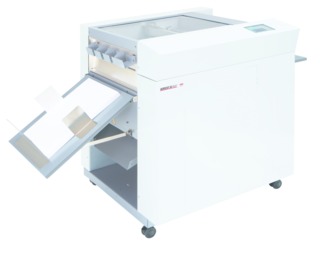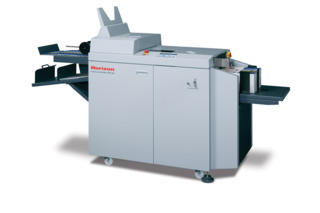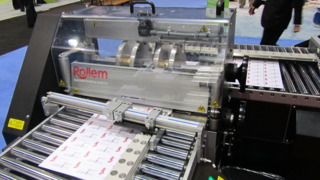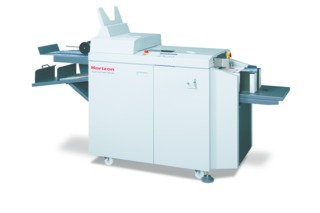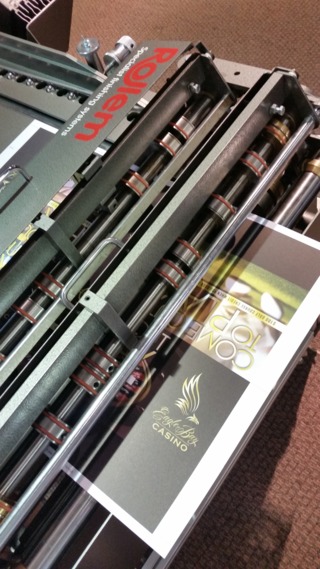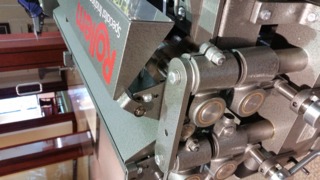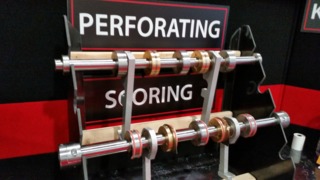Get the Most from Your Finishing Equipment: Scoring, Slitting & Perforating
More than anywhere else within the print production process, profits are lost or gained in the finishing steps.
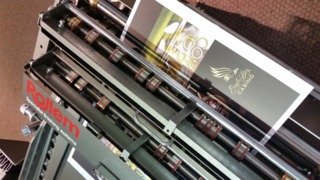
In today’s market, it’s imperative to have equipment that delivers fast, high-quality results. Digital printing’s impact extends to the postpress area, where scoring, slitting and perforating machines play a critical role.
More than anywhere else within the print production process, profits are lost or gained in the finishing steps. This is particularly true in the short-run, high-quality digital print market. Zero or reduced makeready means shorter over-runs and lower print costs.
“Digital printing is taking the industry by storm, and customers are demanding shorter runs, applications that run the gambit, and ultra-fast turnaround with professional results,” noted Neal Swanson, Standard Finishing’s Director of Marketing.
“That said, there’s little margin for waste during set-up and production, and finished jobs need to meet everyone’s expectations…owner and customer alike.”
“Just look at Amazon, which now offers free, same-day delivery on over a million products in 14 metropolitan areas,” added Andre Palko, Technifold USA President.
“Like it or not, that kind of expectation diffuses from retail customers back through to the suppliers in many industries, including graphic arts.”
Quick turnaround and shorter runs demand easy set-ups and changeovers to keep the bindery running smoothly to eliminate the occurrence of bottlenecks, acknowledged Susan Corwin, Rollem International Marketing Manager. “Equally as important are fast production speeds. Digital press output speeds and quality are approaching those of offset presses so the bindery solution must be capable of meeting those speeds.”
Digital, toner-based printers and UV coated stocks demand special attention when cutting and scoring. Fiber cracking often occurs when not using the correct type of score on digital stocks. Also, some UV and raised inks can’t be cut by traditional guillotine cutters.
That’s where advanced scoring, slitting and perforating machines come in. These machines inherent capabilities enable print providers to increase the versatility and flexibility of their production process, ensure accuracy across all functions, and work effectively with digital stocks and inks.
Fifteen years ago a print job had to go through several stages for it to be completed, noted Carrie Ford, Art Director, MBM Corp. Today equipment is available that allows multiple jobs to be cut, slit, and creased in one pass. “This makes production more efficient and most importantly, complete accuracy is ensured compared to the tools used 15 years ago,” she added.
“Brochures, business cards, post cards, CD jackets and more can be creased and trimmed in one operation,” said Ford. “A wide range of stock including gloss, laminated, and UV coated can be creased without cracking, even with full-bleed coverage.”
Combination slitters, creasers and folders are increasingly important to binderies and print service providers meeting the requirements of today’s digital printing environment. Beside the increase in production speed, these machines, such as Standard Finishing’s CRF-362, offer a way to eliminate image cracking and improve finish quality when folding digitally printed sheets, achieving clean crisp accurate creases and folds, even on heavier stocks with full ink or toner coverage, with or without coating.
Duplo’s most automated finishing solutions are its all-in-one sltter/cutter/creasers, which streamline and automate postpress production by trimming white borders and creasing fold lines on digital color documents to prevent toner cracking, Si Nguyen, Duplo USA Vice President, noted.
“In addition, most models offer extended capabilities such as cross perforating, strike perforating, micro perforating, slit scoring, and rotary scoring – enabling print providers to completely finish their applications in a single pass,” said Nguyen.
All Rollem’s machines perform multiple processes of slitting, scoring, and perforating. With their dual shaft design, if one function isn’t needed, the perf head is disengaged for slitting and scoring, explained Corwin. Over 30 styles of scoring and perforating heads, including micro-perforating, deliver a range of finishing options. With the addition of a Rollaway right angle unit, the sheet is processed in one pass, in both directions, ideal for cutting multiple images from a single press sheet, continued Corwin.
In the case of raised inks, Rollem’s rotary slitters cut textures perfectly without any breakage, Corwin said. The Rollem completes 4-sided trimming and multiple slits to eliminate guillotine cutters completely.
Technifold’s products, integrated on advanced models of folding machines, scoring machines and folder gluers, are not just for updating old equipment, Palko commented. “They take even the newest of print finishing machines to the next level by squeezing even more productivity from them. The good news is with the addition of the right accessories, an older machine can become substantially more productive, competitive and profitable. In many cases they come close or even exceed the productivity of newer machines.”
Adding Technifold’s tools to a floor-model folding machine turns a “folding machine” into a scoring, perforating, trimming and folding machine, combining these traditionally separate functions into one, high-speed operation, said Palko. “In a sense you’re turning a folder into a multi-purpose finishing machine.”
With the Standard Horizon CRF-362, not only is creasing, folding and perforating accomplished in one operation but also up and down creasing can be performed in a single pass. Furthermore, a dual delivery is provided for folded and flat processed pieces.
Brochures, menus, marketing pieces, table tents, greeting cards, direct mail and additional value-add products are produced with crease/fold capabilities. Adding perforation, explained Swanson, allows the production of coupon sheets, payment booklets, tear out tabs, and other call-to-action products, while the extra-long sheet length capability allows for the production of double- or single-flap covers for perfect binding and dust jackets for case bound books.
Rollem’s bi-directional strike-slit and strike-perf feature allows sheets to be output with tear-off coupons, reply cards and corner business cards.
“By adding glue and fold units to a Rollem Jetstream slit/score/perf model, the printers can create direct mail pieces with value-added products such as tip-on discount cards, or scratch off applications,” reported Corwin. “These units apply various types of glue for in-line folding and closure, eliminating the need for unslightly tab closures.”
The Jetstream operates in-line with digital presses for fully automated print-finishing lines. “Postcards are typical applications where multiple-up cards are printed with variable data then slit, scored and/or perforated with the Rollem to deliver mail-ready products in one pass,” said Corwin.
Print service providers (PSPs) are often looking to upgrade to equipment that is easier to operate due to improvements in the mechanical setup, as well as faster and more accurate than older models. Newer machines also offer advancements in electronic machine controls that provide tutorial setup, operation, maintenance and job tracking right at the equipment, said Mark Pellman, New Business Development Manager, Baumfolder Corporation.
Single touch processing and automated set-up means more jobs can be produced per shift with fewer operators, lowering production costs and increasing the number of jobs produced per shift.
To help its customers get the most of out of their machines, BAUM provides the BAUM ifold "Infomation" touchscreen control and tutorial as a standard feature on many of its models. This feature enables jobs to be stored for future use, helping to reduce setup time.
Duplo slitter/cutter/creasers, such as model DC-745, come equipped with job template layouts that help printers reduce their effort defining graphic print layouts on fixed media substrates, ranging from 12x18” to 14x20”. Each template has a job file that is uploaded to the slitter/cutter/creaser’s PC Controller software by the operator for automatic job setup. The template is designed to maximize print areas (to take advantage of click charges) while optimizing finishing parameters to the machine’s capability. Operators can also add registration marks and barcodes for a complete job setup to ensure job integrity and prevent operator errors during setup.
Rollem’s programmable control sets job dimension parameters. Strike interrupt feature places slits and perf’s anywhere on the sheet.
MBM’s Aerocut G2 streamlines production with its Adobe InDesign plug-in, which allows designers to set up jobs and transfer the templates from their workstation to the G2, saving production time. The large color touchscreen interface has high capacity program storage, and micro cross-perforating capabilities.
Standard’s CRF-362 stores to memory up to 200 jobs, including all automated settings, for easy recall and automatic set-up in in just seconds. Creasing up and/or down is set automatically based on fold pattern or can be changed at the color monitor.
Six standard fold patterns along with six perfect binding cover patterns with or without hinge scoring are factory installed and easily selectable to accommodate a wide range of applications.
The BAUM 20 VFM Versatile Finishing Modules perform multiple perforating, scoring/creasing and slitting applications. The 20 VFM includes three sets of removable slitter shafts as cartridge sets that can easily be removed and replaced. Modules can be placed offline or in line with other machines to streamline production.
Independent pile and continuous sheet feeders are available with the BAUM 20 IPF and BAUM 20 ICF series machines. These feeders automate production and increase profitability for feeding sheets onto inkjet bases, die cutters and laminator. To increase productivity, the BAUM 20 RCS receding sheet stacker can be placed at the exit end of these devices.
The BAUM 714XLT Ultrafold and BAUM 714XA Autofold air/vacuum feed tabletop folding machines provide a selection of manual and automated setup. BAUM now offers adjustable shafts for these machines to enable select scoring/creasing and microperforating. BAUM also offers a mobile 2nd station right angle folder.
Technifold offers three categories of products: rotary creasing , cutting and perforating. “Our tooling allows a printer to broaden the scope and quality of their offering, reduce production time, and increase profits,” said Palko.
A customer with a scoring or perforating machine that no longer efficiently creases jobs, usually digital, is able to add Tri-Creasers to its scoring machine, and have a useful, productive machine, remarked Palko. “In many cases it becomes the creasing solution for their new digital department,” he added.
Today’s customers routinely require printed and perfed jobs such as forms that can be run at a later date through their own laser printers, copiers, or digital presses. Many of the old-style perforating tools don’t deliver a perforation that’s fine and flat enough to make it through subsequent operations, said Palko. “There’s an annoying tendency to jam or fall apart. So the printer stops using the older OEM perforating tools on their scoring or perforating machine, often sending the job out for finishing or tying up a press for a perf job. The addition of Technifold’s Micro Perforator to the machine allows customers to produce the quality perf expected by their customers. Depending on the model of machine, customers can also do multiple creases and perfs simultaneously.”
Technifold’s Multi Tool for in-line rotary trimming delivers guillotine-quality cutting results in a rotary fashion. “What this means is that you can now run jobs 2- or 3-up on your finishing equipment and then trim them in-line,” Palko remarked. “And you can do this with cover stocks as well as lighter text stocks.”

